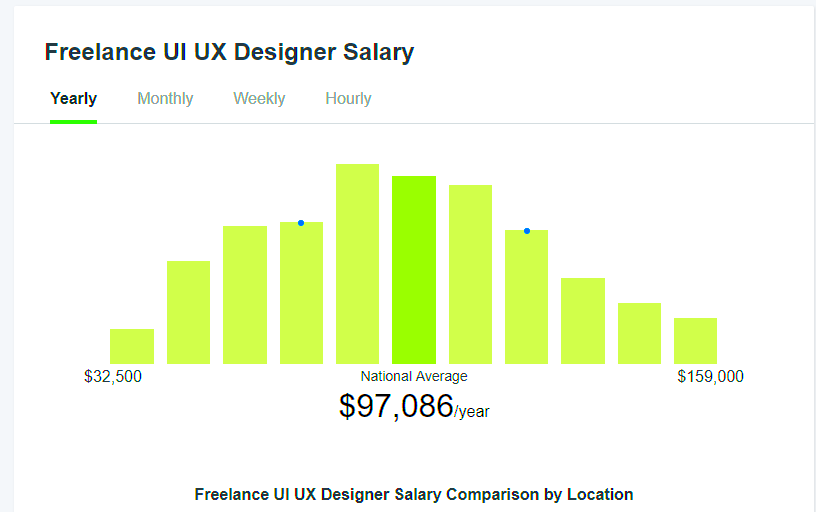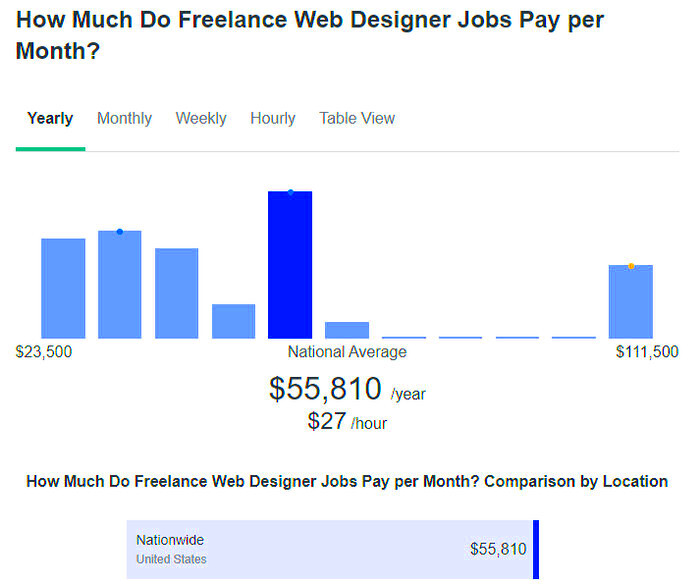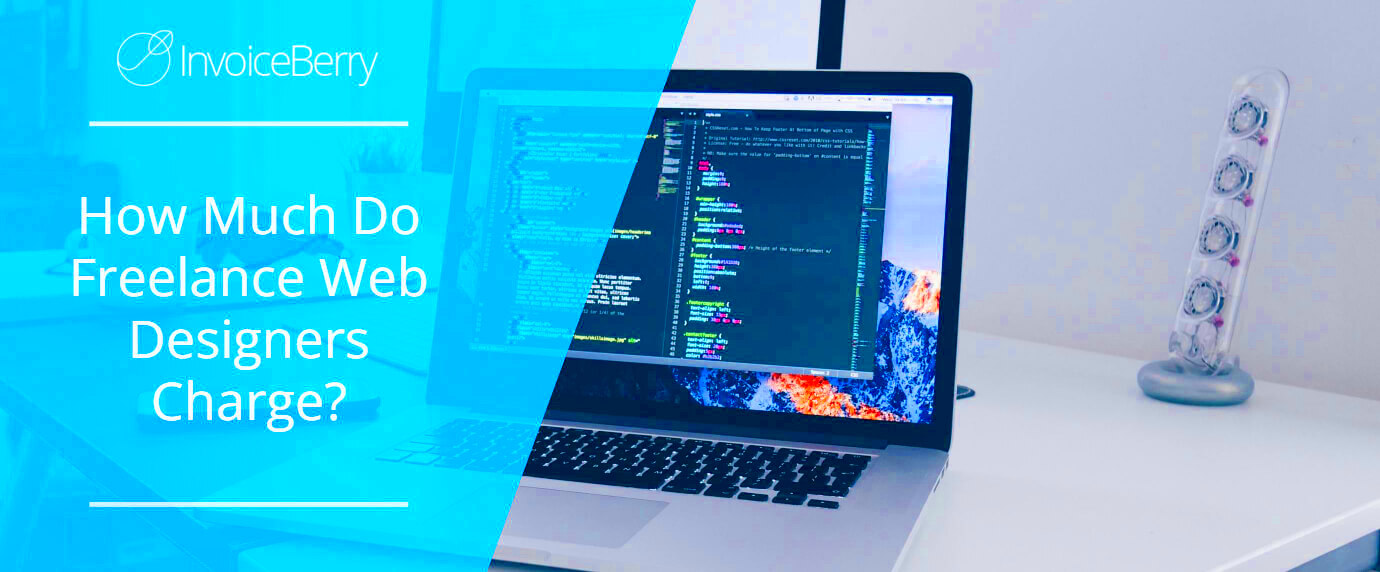Embarking on a path as a freelance web designer can be exhilarating, particularly concerning how much one can earn. In comparison with formal jobs, freelance jobs provide more flexibility in terms of both work and income. There are various factors that determine the amount earned such as one’s level of expertise, type of job and personal skills. As an independent website designer, the money you make is determined largely by the way you promote yourself, what market segment you focus on and whom you work for.
Realizing the factors that affect your income may help you in making decisions aligning with your earning objectives. In this piece, we will look into these aspects and offer guidance on how one can effectively scale their prices in order to optimize revenue.
Factors That Influence Your Earnings

Freelance web designers’ income is not fixed. Here are some crucial points that affect your payment:
- Experience: Beginners may earn less as they build their portfolio, while experienced designers often command higher rates.
- Skillset: Specialized skills like e-commerce development or UX design can justify higher fees, as clients often seek out these expertise.
- Client Type: Working with larger businesses or agencies may bring in higher-paying projects compared to individual clients or small businesses.
- Project Complexity: Complex projects like custom website development often pay more than simple template-based websites.
- Geographic Location: Clients in high-cost regions tend to offer more competitive rates, so your location can play a role.
- Portfolio Quality: A well-curated, high-quality portfolio can attract better clients willing to pay higher fees.
Also Read This: Understanding Views on Fiverr: What They Mean for Your Freelance Business
Setting Your Rates to Maximize Income

Setting freelance rates can be tough. This article offers several methods to help you find out rates that are going to make you earn the most and still keep your clients happy:
- Research Industry Standards: Look up average rates for freelance web designers in your niche and region. This gives you a baseline for setting competitive rates.
- Consider Your Experience and Skills: If you bring unique expertise or have a strong portfolio, don’t be afraid to charge higher rates.
- Offer Project-Based Pricing: Many clients prefer a fixed price over hourly billing. This can be advantageous for you if you estimate the time and resources accurately.
- Use Tiered Pricing: Create pricing packages (e.g., Basic, Standard, Premium) to give clients options, while also encouraging them to choose higher-value packages.
- Regularly Re-evaluate Rates: As you gain experience, revisit your rates periodically to ensure they match your skill level and current market demands.
Having reasonable rates means that you will be in a position to make a constant income and consequently earn more as you gain experience and develop your brand in the freelancing industry.
Also Read This: How to Post Buyer Request on Fiverr
Popular Web Design Niches and Their Earning Potential

Your income can be significantly affected by choosing a niche within web design. Specialization is important as it will make you distinctive, help you attract customers who are looking for specialists in certain domains and enable you to impose higher prices. Different niches in web design come with varying levels of demand and earning potentials; thus, understanding these will help you to choose the best skills to focus on in order to maximize profits.
The earning potential associated with various sectors of web design is huge. Below are some of the most common areas in which designers can work and their expected incomes:
| Niche | Earning Potential (Approximate) | Notes |
|---|---|---|
| eCommerce Web Design | $3,000 - $10,000 per project | High demand as more businesses sell products online; complex sites often command higher fees. |
| User Experience (UX) Design | $50 - $150 per hour | Focuses on usability and user satisfaction, making it valuable for high-profile clients. |
| Branding and Graphic Design Integration | $2,000 - $8,000 per project | Appeals to businesses looking for cohesive brand identity across digital platforms. |
| SEO-Focused Web Design | $75 - $200 per hour | Websites optimized for search engines bring ongoing demand as clients aim for online visibility. |
| Landing Page Design | $500 - $2,000 per page | Often used for marketing campaigns; quick turnarounds make it a popular, profitable niche. |
Concentrating intensely on just one of these niches can really help you get a lot more money in web design because people will see you as a well-known person in this narrow place and thus meet their demands better.
Also Read This: What Type of Freelancer Are You on Fiverr?
How Experience Impacts Your Freelance Income
Freelance earnings are predominantly influenced by your working experience. A newbie takes long before getting consistent clients and building trust on them. However, as time goes by and you accumulate more years in this field, your pay rises substantially for some important reasons:
- Portfolio Growth: With each completed project, you add more work to showcase, making it easier to attract high-paying clients.
- Better Client Referrals: Satisfied clients are likely to recommend you to others, helping you secure more lucrative projects over time.
- Improved Efficiency: As you grow more experienced, you complete tasks faster, allowing you to take on more projects or increase your hourly rate.
- Enhanced Skill Set: Over time, you acquire specialized skills that justify higher rates, especially if you pursue ongoing training or certifications.
On the other hand, those who have been in freelance businesses for some time and have gathered some experience are likely to charge higher as compared to their counterparts who are still starting out. For instance, an amateur could charge between twenty-five to fifty dollars per hour while a pro designer would ask for between seventy-five and one hundred and fifty depending on the level of specialization or kind of project. This mix of experience and expertise leads to earning trust from clients and that is why they can have constant salary as well as make negotiations in favour of them with regards to their contracts.
Also Read This: Can I Post Odd Jobs on Fiverr?
Location and Its Effect on Freelance Web Design Rates
While freelancing is flexible, and allowing remote work, the desirability and cost of living in your location can easily influence how much you charge as a freelance web designer. Therefore, location also determines earnings since your clients’ locations may be different from yours.
This is how your fees may be influenced by location:
- Client Location: Clients from regions with a high cost of living, like North America and Western Europe, tend to have larger budgets for web design projects, often leading to higher fees.
- Your Location: Freelancers based in areas with lower costs of living may find they can charge competitive rates while maintaining a comfortable income, attracting clients looking for quality work at lower costs.
- Market Demand: Some locations have high demand for specific skills, like UX design in tech hubs, which can raise the rates for designers specializing in those areas.
Assuming you live in an expensive area and have clients from that area, your pricing may reflect the rates of your region. Living in a place with cheap living costs yet targeting clients from rich places gives you an upper hand as you will charge low but keep up with your income standards. In the freelance web design industry, location can be a powerful tool for achieving success.
Also Read This: Who Takes the Hit? Understanding Fiverr Discounts
Strategies for Increasing Your Earnings
Freelance web designers have a myriad of options when it comes to increasing their income apart from normal project charges. The strategies highlighted here aim at leveraging on skills, enhancing client relations, and streamlining work processes. Through the integration of some of these concepts into their operations, they stand to gain more revenue while at the same time boosting service quality.
Here are some ways that work well:
- Expand Your Skill Set: Learning additional skills like UX design, SEO, or front-end development allows you to offer a more comprehensive service package, justifying higher rates.
- Build Long-Term Client Relationships: Focus on client retention by providing exceptional service and proactive communication. Long-term clients often offer steady work and may agree to higher rates over time.
- Offer Add-On Services: Include related services like website maintenance, content updates, or digital marketing. Add-ons can increase project value and provide recurring income.
- Streamline Your Workflow: Efficient tools and methods (like design templates and automation software) help complete projects faster, allowing you to take on more work or charge by project rather than hourly.
- Position Yourself as an Expert: Build your reputation by showcasing your portfolio, engaging in professional networks, and sharing insights on platforms like LinkedIn or a personal blog.
Steadily employing these techniques may ensure that you get higher profits and a viable long-term source of income from your freelance profession.
Also Read This: How to Get Hits on Fiverr: Proven Strategies for Success
Common Questions about Freelance Web Designer Earnings
Freelance web design can be a tricky terrain to traverse when it comes to income expectations and financial management - especially if you want to remain afloat in the industry. Here are some of the most common inquiries related to this topic:
How much can a beginner freelance web designer expect to make?
The inexperienced and newly-started freelance web designers get a pay of between twenty to fifty dollars on each hour worked. Further, the income tends to increase as one gains more experience and specializes in certain fields.
How do I determine a fair rate for my services?
Conduct a study concerning the necessary requirements of the industrial sector, examine your capacity and analyze the market in your vicinity. Strive for rates that are not only appealing but will also serve as a criterion for measuring the quality of life.
Is hourly or project-based pricing better?
There are advantages and disadvantages to both. Hourly rates provide more freedom while project-based pricing tends to have better payoffs when done properly.
What additional costs should freelancers plan for?
When establishing rates and planning income objectives, freelancers must take into consideration expenses such as taxation, software subscriptions, and professional growth.
Final Thoughts on Earnings as a Freelance Web Designer
Freelance web design is a job that can yield significant income, allowing you to modify your services according to your needs and increase your earning over time. While several factors such as niche, experience, and geographical location affect the amount of money earned by web designers, having specific objectives and being wise about how they are achieved can play an important role in determining one’s financial fate. In order to achieve a lasting income, you must build good name for yourself, learn new methods of operation and keep learning from clients.
For a freelancer,it is important to note that one’s income is not static.The possibility of increasing earnings overtime is reliant on how well the person is able to adjust to the market needs and enhance his or her skills as well as making sure that clients are satisfied.The right way of handling it makes freelance web designing a very satisfying and lucrative option for an individual to pursue as a profession.




